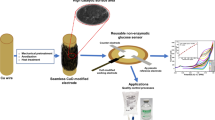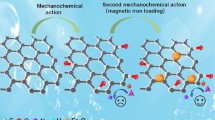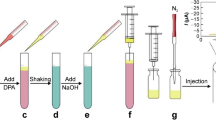Abstract
Hemin was physically adsorbed onto porous carbon felt (CF), a microelectrode ensemble of micro-carbon fiber (ca. 7 μm in diameter) and possessing a three-dimensional random structure. The hemin-CF exhibited a well-defined redox wave that is due to Fe(III)/Fe(II) redox process in hemin, with a formal potential of −0.32 V (vs. Ag/AgCl) in deoxygenated buffer solution of pH 7.0. The surface coverage of the electroactive hemin molecules on the surface of the CF was calculated to be 5.0 × 10−11 mol cm−2, and the apparent heterogeneous electron transfer rate constant is 3.35 s−1. The hemin-CF electrode displays excellent electrocatalytic activity for the reduction of dissolved oxygen (DO), and the magnitude of the cathodic current increases with increasing concentrations of DO in the sample solution. The electrode was used as a flow-through detector for sensitive and rapid consecutive determination of DO. Deoxygenated pH 7.0 solutions were analyzed at a flow rate of 8.0 mL min−1 at an applied potential of −0.2 V, and highly reproducible cathodic peak current responses to DO were observed in the 0.72 to 13.3 mg L−1 concentration range. The maximum throughput is 170 samples h−1. The hemin-CF-based amperometric flow-sensor was applied to determine the concentration of DO in environmental water samples.

Hemin was physically adsorbed onto porous carbon felt (CF), a microelectrode ensemble of micro-carbon fiber (ca. 7 μm in diameter). The hemin-CF electrode was used as a flow-through detector for highly sensitive and rapid determination of dissolved oxygen.





Similar content being viewed by others
References
Stetter JR, Li J (2008) Amperometric gas sensors—A review. Chem Rev 108:352–366
Ramamoorthy R, Dutta PK, Akbar SA (2003) Oxygen sensors: materials, methods, designs and applications. J Mater Sci 384:271–4282
Mutton L, Newton ME, Unwin PR, Macpherson JV (2009) Amperometric oxygen sensor based on a platinum nanoparticle-modified polycrystalline boron doped diamond disk electrode. Anal Chem 81:1023–1032
Zen JM, Song YS, Chung HH, Hsu CT, Kumer AS (2002) Photoelectrochemical oxygen sensor using copper-plated screen-printed electrodes. Anal Chem 74:6126–6130
Shitanda I, Mori S, Itagaki M (2011) Screen-printed dissolved oxygen sensor based on cerium oxide-supported silver catalyst and polydimethylsiloxane film. Anal Sci 27:1049–1052
Luz RCS, Damos SF, Tanaka AA, Kubota LT (2006) Dissolved oxygen sensor based on cobalt tetrasulphonated phthalocyanine immobilized in poly-L-lysine film onto glassy carbon electrode. Sensors Actuators B 114:1019–1027
Zheng N, Zeng Y, Osborne PG, Li Y, Chang W, Wang Z (2002) Electrocatalytic reduction of dioxygen on hemin based carbon paste electrode. J Appl Electrochem 32:129–133
Ye JS, Wen Y, Zhang WD, Cui HF, Gan LM, Xu GQ, Sheu FS (2004) Application of multi-walled carbon nanotubes functionalized with hemin for oxygen detection in neutral solution. J Electroanal Chem 562:241–246
Zhao CL, Bai H, Shi G (2011) Electrochemical detection of dioxygen and hydrogen peroxide by hemin immobilized on chemically converted graphene. J Electroanal Chem 657:34–38
Feng JJ, Li ZH, Li YF, Wang AJ, Zhang PP (2012) Electrochemical determination of dioxygen and hydrogen peroxide using Fe3O4@SiO2@hemin microparticles. Microchim Acta 176:201–208
Kato K, Kano K, Ikeda T (2000) Electrochemical characterization of carbon felt electrodes for bulk electrolysis and for biocatalyst-assisted electrolysis. J Electrochem Soc 147:1449–1453
Ducey MW Jr, Meyerhoff ME (1998) Microporous gold electrodes as combined biosensor/electrochemical detectors in flowing streams. Electroanalysis 10:157–162
Lawrence NS, Davis J, Marken F, Jiang L, Jones TGJ, Davis SN, Compton RG (2000) Electrochemical detection of sulphide: a novel dual flow cell. Sensors Actuators B 69:189–192
Blaedel WJ, Wang J (1979) Flow analysis on reticulated vitreous carbon electrode. Anal Chem 51:799–802
Wang Y, Hasebe Y (2009) Carbon felt-based biocatalytic enzymatic flow-through detectors: chemical modification of tyrosinase onto amino-functionalized carbon felt using various coupling reagents. Talanta 79:1135–1141
Wang Y, Hasbe Y (2011) Carbon felt-based bioelectrocatalytic flow-through detectors: Highly sensitive amperometric determination of H2O2 based on a direct electrochemistry of covalently modified horseradish peroxidase using cyanuric chloride as a linking agent. Sensors Actuators B 155:722–729
Wang Y, Hasebe Y (2012) Glucose oxidase-modified carbon-felt-reactor coupled with peroxidase-modified carbon-felt-detector for amperometric flow determination of glucose. Mater Sci Eng C 32:432–439
Shigehara K, Anson FC (1982) Electrocatalytic activity of three iron porphyrins in the reduction of dioxygen and hydrogen peroxide at graphite electrodes. J Phys Chem 86:2776–2783
Antoniadou S, Jannakoudakis AD, Theodoridou E (1989) Electrocatalytic reactions on carbon fiber electrodes modified by hemin I. Electroreduction of oxygen. Synth Met 30:283–294
Arifuku F, Mori K, Muratani T, Kurihara H (1992) The catalytic electroreduction of dioxygen on iron protoporphyrin IX modified glassy carbon electrodes. Bull Chem Soc Jpn 65:1491–1495
Liang ZX, Song HY, Liao SJ (2011) Hemin: A highly effective electrocatalyst mediating the oxygen reduction reaction. J Phys Chem 115:2604–2610
De Groot MT, Merkx M, Wonders AH, Koper MTM (2005) Electrochemical reduction of NO by hemin adsorbed at pyrolytic graphite. J Am Chem Soc 127:7579–7586
Tao NJ, Cardenas G, Cunha F, Shi Z (1995) In situ STM and AFM study of protoporphyrin and iron(III) and zinc(II) protoporphyrins adsorbed on graphite in aqueous solutions. Langmuir 11:4445–4448
Sagara T, Fukuda M, Nakashima N (1998) Electroreflectance study of hemin adsorbed on a HOPG electrode: estimation of molecular orientation and analysis of nonfaradaic elecroreflectance signal due to the stark effect. J Phys Chem B 102:521–527
Bond AM (1980) Modern polarographic methods in analytical chemistry. Marcel Dekker, New York
Kolpin CF, Swofford HS Jr (1978) Adsorption preconcentration for the direct analytical determination of heme. Anal Chem 50:916–920
Murray RW (1984) In: Bard AJ (ed) Electroanalytical Chemistry, vol 13. Marcel Dekker, New York, pp 191–368
Laviron E (1979) General expression of the linear potential sweep voltammogram in the case of diffusionless electrochemical systems. J Electroanal Chem 101:19–28
Ma Q, Ai S, Yin H, Chen Q, Tang T (2010) Toward the conception of an amperometric sensor for L-tyrosine based on hemin/PAMAM/MWCNT modified glassy carbon electrode. Electrochim Acta 55:6687–6694
Turdean GL, Popescu IC, Curulli A, Palleschi G (2006) Iron(III) protoporphyrin IX-single-wall carbon nanotubes modified electrodes for hydrogen peroxide and nitrite detection. Electrochim Acta 51:6435–6441
Yasukawa T, Maekawa E, Mizutani F (2009) Amperometric glucose sensors utilizing the permeability of oxygen and hydrogen peroxide through a poly(dimethylsiloxane) layer. Bunseki Kagaku (in Japanese) 58:639–644
Hasebe Y, Wang Y (2013) Sensitive voltammetric and amperometric responses of respiratory toxins at hemin-adsorbed carbon-felt. J Environ Sci 25:1055–1062
Acknowledgments
This research was financially supported in part by the NEXT-supported Program (2011–2015) for Strategic Research Foundation at Private Universities from the Ministry of Education, Science and Culture of Japan.
Author information
Authors and Affiliations
Corresponding author
Electronic supplementary material
Below is the link to the electronic supplementary material.
ESM 1
(DOC 169 kb)
Rights and permissions
About this article
Cite this article
Wang, Y., Hosono, T. & Hasebe, Y. Hemin-adsorbed carbon felt for sensitive and rapid flow-amperometric detection of dissolved oxygen. Microchim Acta 180, 1295–1302 (2013). https://doi.org/10.1007/s00604-013-1057-9
Received:
Accepted:
Published:
Issue Date:
DOI: https://doi.org/10.1007/s00604-013-1057-9




